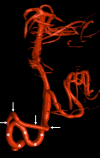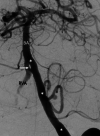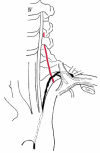Accessory Vertebral Artery: An Embryological Review With Translation from Adachi
- PMID: 33767932
- PMCID: PMC7982507
- DOI: 10.7759/cureus.13448
Accessory Vertebral Artery: An Embryological Review With Translation from Adachi
Abstract
The vertebral arteries arise from the posterior superior aspect of the bilateral subclavian arteries and course superiorly through the transverse foramina of C1-C6 vertebrae before joining one another along the anterior surface of the pons. Developmental variations during the fourth to sixth weeks of embryonic development may result in the formation of accessory vertebral arteries, i.e., ipsilateral vertebral arteries of dual origin. This anatomical variation is distinct from and often confused with vertebral artery duplications and fenestrations. This article reviews the anatomy and embryology of the accessory vertebral artery with excerpts from Buntaro Adachi's classic text on vascular anatomical variations. Knowledge of accessory vertebral vessels is important during vascular and spinal procedures of the head and neck. Furthermore, these variations have been associated with cerebrovascular pathologies, such as stroke, dissection, and other hemodynamic anomalies.
Keywords: accessory vertebral artery; buntaro adachi; embryology; vascular surgery.
Copyright © 2021, Bordes et al.
Conflict of interest statement
The authors have declared that no competing interests exist.
Figures













References
-
- Aortic arch origin of the left vertebral artery: an anatomical and radiological study with significance for avoiding complications with anterior approaches to the cervical spine. Tardieu G, Edwards B, Alonso F, et al. Clin Anat. 2017;30:811–816. - PubMed
-
- A case of duplicated right vertebral artery. Motomura M, Watanabe K, Tabira Y, et al. Kurume Med J. 2018;64:69–73. - PubMed
-
- Vertebral artery anatomical variations as they relate to cervical transforaminal epidural steroid injections. Gitkind AI, Olson TR, Downie SA. Pain Med. 2014;15:1109–1114. - PubMed
-
- Variations of transverse foramina in cervical vertebrae: what happens to the vertebral artery? Zibis A, Mitrousias V, Galanakis N, Chalampalaki N, Arvanitis D, Karantanas A. Eur Spine J. 2018;27:1278–1285. - PubMed
Publication types
LinkOut - more resources
Full Text Sources
Other Literature Sources
